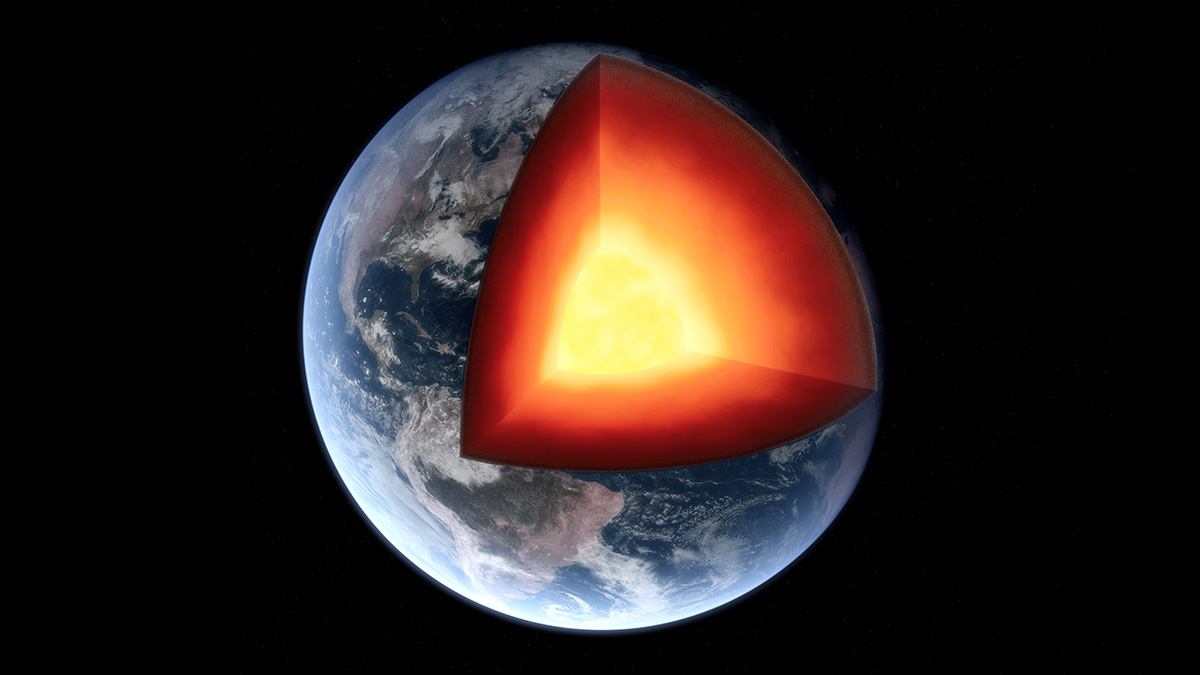Earth’s inner core is a ball of solid metal as hot as the surface of the Sun, rotating in a molten tempest of iron and nickel—Hades, if ever there were one. The sphere is ever growing as the surrounding liquid outer core slowly cools and crystallizes, driving convection and the geodynamo, which provides Earth’s magnetic field.
Though sci-fi fantasy posits a doomsday scenario in which the revolving sphere abruptly comes to a halt and wreaks havoc at Earth’s surface, there is no scientific evidence that such an event is possible. However, new research recently published in Science Advances showed that the core’s rotation may speed up and slow down with regularity. The discovery could help scientists understand other phenomena with similar periodicity and unriddle one of Earth’s greatest mysteries.
Explosions Illuminate the Depths
Peering down at Earth’s deepest recess is more complicated than simply digging a big hole; the inner core boundary is more than 5,000 kilometers below the surface. Instead, scientists have relied on seismic waves bending and ricocheting off Earth’s inner layers to glimpse at deep structure and behavior over time. In most studies, those waves have originated from large earthquakes.
Searching for clearer insight into the workings of the inner core, Wei Wang and John Vidale, seismologists at the University of Southern California and coauthors of the new study, eyed nuclear weapons tests as a source of core-penetrating waves.
“Explosions are good because they’re a very sharp source,” said Vidale. “They’re very brief, but they’re very powerful.”
Earthquakes, conversely, can last for tens of seconds, obscuring crisp seismic waves. They are also hard to locate with precision. On the other hand, “we exactly know the location of the nuclear test,” explained Wang. When measuring minute changes in the relative rotation of the core, knowing where the waves come from is crucial.
Wang and Vidale analyzed data from the Large Aperture Seismic Array (LASA), a network of more than 300 seismic stations in Montana, which recorded a series of buried nuclear explosions in the 1960s and 1970s. “The array we’re using—the LASA array—is unique,” Vidale said. The stations, decommissioned in the 1970s, were closely spaced, giving seismologists the resolution needed to tease out small shifts in scattering waves.
“It’s just lucky for us that they tend to pulverize the ground in the same place several years apart.”
Wang and Vidale looked at LASA data—rescued from old magnetic tapes—for two sets of explosions: two Russian detonations, in 1971 and 1974, and an American pair in 1969 and 1971. Both explosions in each pair took place roughly in the same location, allowing the researchers to directly compare the data and avoid complexity coming from large-scale differences in Earth’s structure. “It’s just lucky for us that they tend to pulverize the ground in the same place several years apart,” Vidale said.
The researchers looked at how waves scattered as they interacted with structures within the inner core. Between the two detonations in each location, the scatter pattern had shifted, indicating the inner core had moved relative to the surface.
Vidale and colleagues had previously shown that between the Russian detonations in 1971 and 1974, the inner core rotated 0.1° faster per year than the mantle above. But Wang and Vidale calculated that between 1969 and 1971, it rotated 0.05° slower per year, suggesting that the inner core regularly speeds up and slows down.
A periodic wobble of the inner core could explain other phenomena such as the 6-year oscillation in the length of a day, according to Wang and Vidale. Further modeling of the data showed that their theory is consistent with a 6-year periodicity to the rotation.
The notion that the inner core oscillates has been suggested in the past, though it has been difficult to prove. “[Wang and Vidale] really have the most definitive, convincing evidence that the inner core is sort of wiggling back and forth,” said Keith Koper, a seismologist at the University of Utah who was not involved with the study.
Battle at the Center of the Earth
Given the challenges of peering so deeply into Earth, there is understandable debate about what scientists are actually seeing in their data. Since the 1990s, when people first recognized that the rotation of the inner core was not in lockstep with the rest of the planet, researchers have argued over what is going on down there.
For instance, early seismic data indicated that the inner core consistently rotates much faster than the mantle—roughly 1° per year. The LASA data suggested that the difference is an order of magnitude smaller—just 0.1° faster per year—and is constantly changing.
“I’m not sure there are very many things in Earth sciences that are as unresolved as the motion of the inner core.”
“I do not doubt that there were some scattered waves that changed [in the LASA data],” said Lianxing Wen, a seismologist at Stony Brook University who was not involved in the research. “I just think that we are really looking at the wrong interpretation.” Wen and his colleagues previously showed that topography on the inner core surface is dynamic; peaks and valleys form over human timescales and would account for different wave characteristics. The rotation theory is inconsistent with other seismic evidence, he said.
Others disagreed. Hills and valleys on the inner core boundary just can’t explain these new observations in the core, Koper said.
Clearly, the science is far from resolved. “I’m not sure there are very many things in Earth sciences that are as unresolved as the motion of the inner core,” Vidale said. “It’s a long-standing battle to try to figure out exactly what’s happening.”
—Jennifer Schmidt (@DrJenGEO), Science Writer

